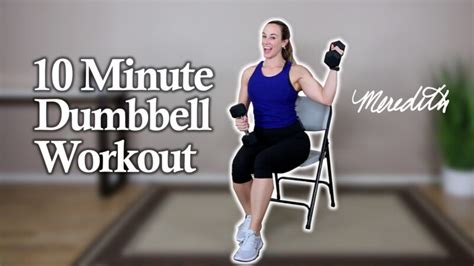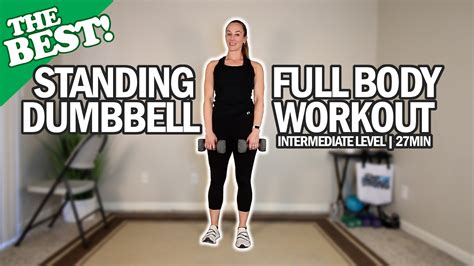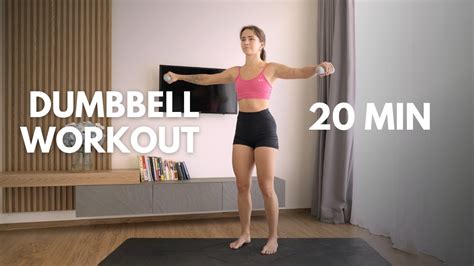Staying fit and active is essential for seniors to maintain mobility, strength, and overall health. Incorporating full-body dumbbell exercises into a regular fitness routine is an effective way to achieve this. These exercises not only help improve muscle strength but also enhance balance, flexibility, and endurance. In this article, we’ll explore the 10 best full-body dumbbell exercises that are ideal for seniors, focusing on movements that target all major muscle groups while being gentle on joints. Whether you’re new to strength training or looking to maintain an active lifestyle, these exercises will help you stay strong and healthy as you age.
Discover the intricacies of this topic with ujocis.net
1. Warm-Up Routine
Before starting any workout, especially for seniors, it’s important to engage in a proper warm-up to prepare the body for exercise and reduce the risk of injury. A good warm-up should increase blood flow, elevate the heart rate, and loosen up muscles and joints. Begin with 5–10 minutes of light cardio, such as brisk walking, marching in place, or gentle cycling. Follow this with dynamic stretches targeting the muscles you’ll be using during your dumbbell exercises, like arm circles, shoulder rolls, and leg swings. Focus on warming up key areas like the shoulders, hips, and lower back. Incorporating some deep breathing exercises during the warm-up can help promote relaxation and steady breathing throughout the workout. This routine ensures that your muscles are primed for movement, improves flexibility, and enhances overall performance. Warming up properly helps create a safer and more effective exercise session, especially for seniors looking to stay fit and active.

2. Dumbbell Squats
Dumbbell squats are an excellent lower-body exercise that targets the quadriceps, hamstrings, glutes, and core muscles. For seniors, this exercise helps improve leg strength, balance, and stability, which are crucial for maintaining independence and preventing falls.
To perform dumbbell squats, start by standing with your feet shoulder-width apart, holding a light dumbbell in each hand by your sides. Keep your chest up, shoulders back, and engage your core. Slowly bend your knees and lower your body as if sitting back into a chair, keeping your weight in your heels and ensuring your knees don’t extend past your toes. Lower yourself until your thighs are parallel to the ground or as far as your mobility allows, then push through your heels to return to a standing position.
Focus on controlled movements and proper form to avoid strain on the knees or lower back. Begin with a manageable weight and increase gradually as strength improves. Dumbbell squats can be modified to suit different fitness levels, making them a versatile and effective exercise for seniors looking to enhance lower body strength and stability.

3. Dumbbell Deadlifts
Dumbbell deadlifts are a great exercise for strengthening the lower back, glutes, hamstrings, and core, which are essential for posture, stability, and overall mobility in seniors. This exercise helps improve functional strength, making daily activities like bending and lifting easier and safer.
To perform a dumbbell deadlift, begin by standing with your feet hip-width apart, holding a dumbbell in each hand in front of your thighs with your palms facing your body. Keep your back straight, chest up, and shoulders back. Slowly hinge at the hips, pushing them backward while lowering the dumbbells toward the ground, keeping them close to your legs. Your knees should be slightly bent, and your back should remain neutral throughout the movement. Lower the dumbbells until you feel a stretch in your hamstrings or until your torso is nearly parallel to the ground. Engage your glutes and hamstrings to return to a standing position, squeezing your glutes at the top.
It’s important to maintain proper form to avoid strain on the lower back. Start with light weights and gradually increase as strength improves.

4. Dumbbell Chest Press
The dumbbell chest press is a key exercise for strengthening the chest, shoulders, and triceps, promoting upper body strength and endurance. For seniors, this exercise can help improve daily activities that involve pushing motions, like opening doors or lifting objects.
To perform the dumbbell chest press, start by lying on a flat bench or the floor, with a dumbbell in each hand. Hold the dumbbells at chest level, with your elbows bent at a 90-degree angle and your palms facing forward. Keep your feet flat on the floor and your core engaged to support your lower back. Slowly press the dumbbells upward by extending your arms until they are fully straight, ensuring the weights are directly over your chest. Pause briefly at the top, then lower the dumbbells back to the starting position with control.
It’s important to focus on smooth, controlled movements to avoid straining the shoulder joints. Begin with light weights and gradually increase as strength improves. The dumbbell chest press is a safe and effective exercise for building upper body strength in seniors.
5. Dumbbell Rows
Dumbbell rows are a highly effective exercise for strengthening the upper back, shoulders, and biceps. For seniors, this exercise enhances posture, improves upper body strength, and helps with movements that involve pulling or lifting.
To perform a dumbbell row, start by placing one knee and hand on a flat bench for support, keeping your back straight and parallel to the floor. Hold a dumbbell in the opposite hand with your arm fully extended toward the floor. Engage your core to stabilize your body. Pull the dumbbell upward toward your hip, keeping your elbow close to your body and squeezing your shoulder blade at the top of the movement. Lower the dumbbell back to the starting position in a controlled manner. Complete the desired number of repetitions, then switch sides.
Maintain a neutral spine throughout the exercise to avoid lower back strain. Begin with a lighter weight to focus on proper form, gradually increasing as strength improves. Dumbbell rows are a valuable addition to any senior’s fitness routine, promoting upper body strength and stability.
6. Dumbbell Overhead Press
The dumbbell overhead press is a fundamental exercise for strengthening the shoulders, triceps, and upper chest. For seniors, this exercise helps improve arm strength and shoulder stability, which is essential for tasks that involve reaching and lifting overhead.
To perform the dumbbell overhead press, begin by sitting on a sturdy chair or bench with back support, holding a dumbbell in each hand at shoulder height. Your palms should face forward, and your elbows should be bent at about 90 degrees. Keep your feet flat on the floor and your core engaged to support your lower back. Press the dumbbells upward, extending your arms fully and bringing the weights directly above your head. Avoid arching your back by maintaining a neutral spine throughout the movement. Pause briefly at the top, then slowly lower the dumbbells back to the starting position, keeping control of the weights.
Focus on smooth, controlled movements to avoid straining your shoulders or upper back. Start with a lighter weight to master the technique and gradually increase the load as you build strength. The dumbbell overhead press is an excellent exercise for enhancing upper body strength and functionality in everyday activities, making it a valuable addition to a sen
7. Dumbbell Bicep Curls
Dumbbell bicep curls are a classic exercise for targeting the biceps, which are essential for lifting and carrying objects. For seniors, this exercise helps build arm strength and improve functional movements, making everyday tasks easier.
To perform a dumbbell bicep curl, stand with your feet shoulder-width apart and hold a dumbbell in each hand with your arms fully extended and palms facing forward. Keep your elbows close to your torso and your core engaged to maintain stability. Slowly curl the dumbbells upward by bending your elbows, bringing the weights toward your shoulders. Focus on contracting your biceps throughout the movement. Avoid swinging your arms or using momentum; instead, maintain controlled, steady motion. Once you reach the top of the curl, pause briefly, then slowly lower the dumbbells back to the starting position, fully extending your arms.
Performing bicep curls with proper form helps prevent strain on the elbows and shoulders. Start with a lighter weight to focus on technique and gradually increase the weight as you gain strength. This exercise is effective for enhancing arm strength and overall upper body function, making it
8. Dumbbell Tricep Extensions
Dumbbell tricep extensions are an excellent exercise for targeting the triceps, the muscles located at the back of the upper arms. For seniors, strengthening the triceps helps improve arm strength and enhances the ability to push or lift objects.
To perform a dumbbell tricep extension, start by standing or sitting with your back straight and holding a dumbbell with both hands. Extend your arms overhead, keeping your elbows close to your head. Slowly lower the dumbbell behind your head by bending your elbows, allowing the weight to descend as far as your flexibility allows. Keep your upper arms stationary and focus on contracting your triceps as you lift the dumbbell back to the starting position.
Ensure smooth, controlled movements throughout the exercise to avoid straining your shoulders or elbows. Begin with a lighter weight to perfect your form and increase gradually as you build strength. Dumbbell tricep extensions are effective for enhancing arm strength and functional capabilities, making them a valuable addition to a senior’s fitness routine.
9. Dumbbell Lunges
Dumbbell lunges are a powerful exercise for strengthening the legs and improving balance and stability, which are crucial for seniors to maintain mobility and prevent falls. This exercise targets the quadriceps, hamstrings, glutes, and calves.
To perform a dumbbell lunge, start by standing with your feet hip-width apart, holding a dumbbell in each hand by your sides. Step forward with one foot, lowering your body until both knees are bent at about 90 degrees. Your back knee should hover just above the ground, and your front knee should be directly above your ankle. Keep your torso upright and engage your core to maintain balance. Push off with your front foot to return to the starting position. Alternate legs, performing the desired number of repetitions for each side.
Focus on controlled movements and proper alignment to avoid strain on the knees or lower back. Begin with a lighter weight and gradually increase as your strength and balance improve. Dumbbell lunges are a versatile and effective exercise that enhances lower body strength and stability, making them an essential part of a senior’s exercise routine.
10. Cool-Down and Stretching
Cooling down and stretching after a workout is crucial for seniors to help prevent muscle stiffness, reduce the risk of injury, and promote overall flexibility. A proper cool-down helps transition the body from an active state to a resting state, allowing the heart rate to gradually return to normal and aiding in recovery.
Start your cool-down with 5–10 minutes of light cardio, such as walking at a gentle pace or slow cycling. This helps gradually lower your heart rate and relax your muscles. Follow this with a series of static stretches targeting the major muscle groups used during your workout.
Focus on stretches for the legs, arms, and back, such as hamstring stretches, quad stretches, and shoulder stretches. Hold each stretch for about 20–30 seconds, breathing deeply and gently pushing into the stretch without causing discomfort. Include stretches for the chest and upper back to counterbalance the pressing exercises.
Incorporating deep breathing exercises during your cool-down can further promote relaxation and stress relief. A proper cool-down not only aids in muscle recovery but also contributes to overall flexibility and well-being, making it an essential component of a senior’s exercise routine.
Incorporating these 10 full-body dumbbell exercises into your routine can greatly enhance strength, balance, and overall fitness for seniors. By focusing on proper form and gradually increasing weights, you can safely build muscle and improve daily functional movements. Remember to always warm up before starting and cool down afterward to support recovery. Embrace these exercises to stay active, independent, and healthy as you age.
ujocis.net

